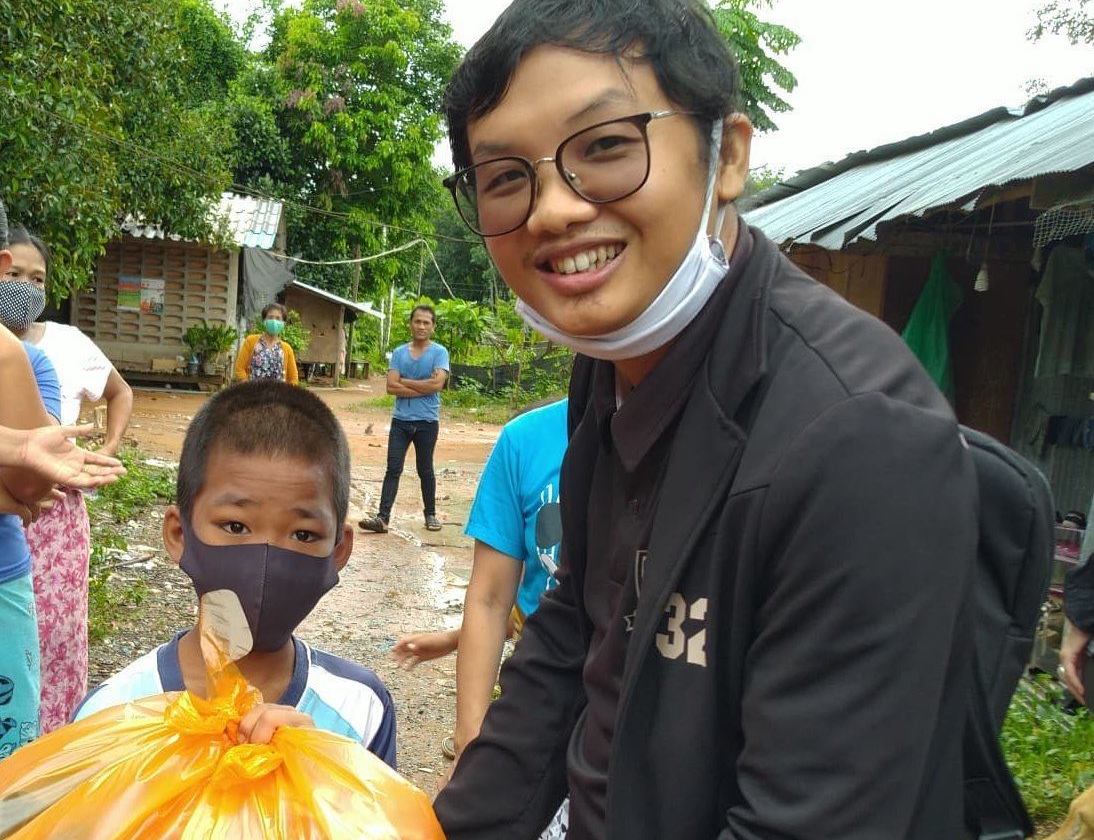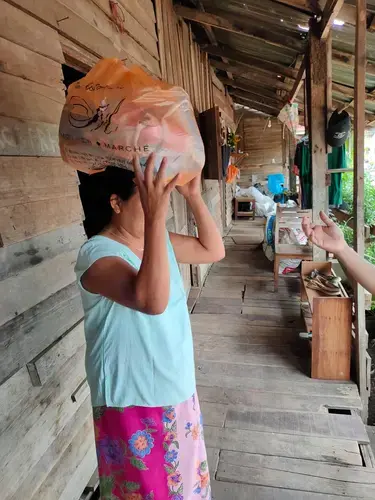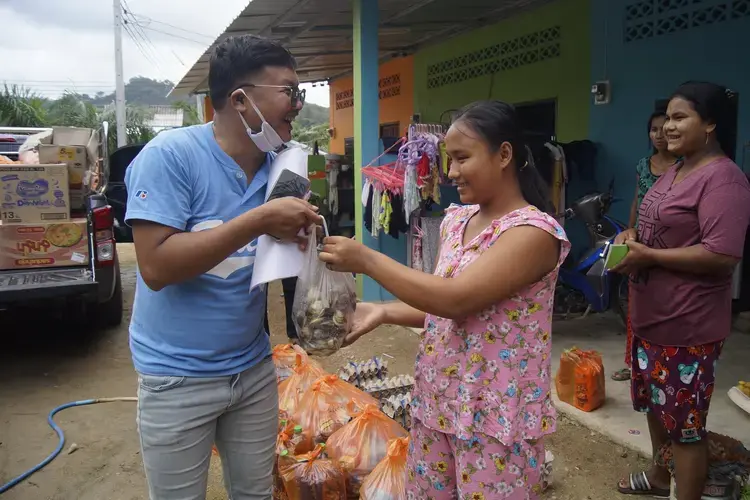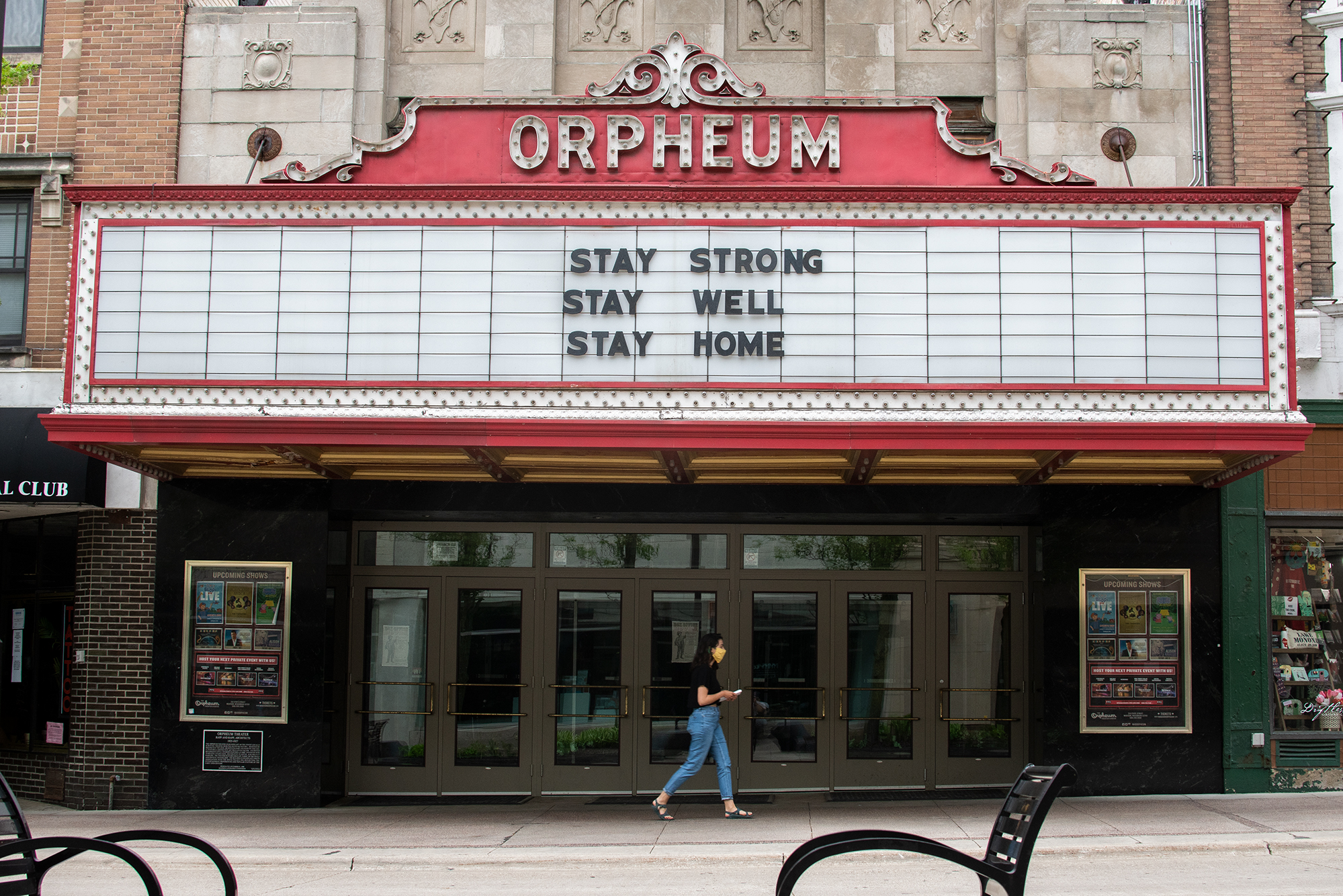
Khao Lak, a collection of villages in Thailand’s verdurous Phang Nga Province, seemed an ideal destination for Burmese migrant workers from Myanmar. Unlike the barren job market at home, Khao Lak offered ample opportunities in the hospitality and rubber industries. In Phang Nga, Burmese migrants could earn enough to live modestly and send remittances to relatives at home.
The pandemic changed everything.
COVID-19 decimated Thailand’s tourism and rubber industries and, by extension, its economy. The Thai government declared a state of emergency March 26, 2020, and imposed curfews, partial lockdowns, and closed most border checkpoints, thus halting tourism and commerce. In August, Thailand’s National Economic and Social Development Council announced that the country’s economy contracted by 12.2 percent in the second quarter. Nearly three-quarters of Thailand’s labor force suffered major income losses, according to Thailand’s National Economic and Social Development Council.
Thailand’s migrant workers, who primarily hail from Myanmar, Cambodia, Vietnam, and the Lao People’s Democratic Republic, have been hit hardest. In a recent assessment of Thailand’s migrants, the International Organization of Migration (IOM) reported that 57 percent of respondents said that insufficient income is the greatest challenge they currently face.
In addition to losing their already meager incomes, migrant workers must navigate a labyrinthine immigration system, fight for health care they are lawfully owed, and struggle to survive until the border opens and they can return home.
Food Is First
In Phang Nga alone, there are roughly 50,000 Burmese migrants, 40 percent of whom have no health insurance, according to the Foundation for Education and Development (FED).
Hmine (who requested to be identified by first name only for reasons of privacy and safety), a Burmese migrant coordinating mutual aid in Khao Lak, knows better than anyone the adverse effects of the pandemic. “COVID has ruined all of the migrants’ business in Thailand,” Hmine said. “Here most of the migrant workers—their life and community—depend on hospitality. All of the hospitality business is closed down right now, so about 60 percent of the workers are jobless.”
An educator and activist, Hmine has been urging NGOs to support the migrant families in Khao Lak. A recent funding proposal he drafted requested a weekly stipend of 400 Thai baht ($12) per family. This would cover basics such as rice, cooking oil and coffee mix.
“Food is first. COVID is second,” Hmine said of the migrants’ current needs. “Some parents work only one or two days a week, so they can’t afford to buy food. Kids are starving and crying, and the parents can’t afford anything.”
The IOM assessment said that 76 percent of key informants reported hearing concerns about food shortages among migrant communities, while 21 percent reported families going full days without eating due to the economic stress of the pandemic.
The situation is only getting worse. Last month, Hmine supported 40 families in his community with food and necessities. This month, he predicts over 50 families will request support.
Lack of food isn’t the sole issue facing migrants. Those who have lost their jobs can no longer pay rent, and while some landlords have been accommodating, others are evicting their tenants. Some evicted families now reside in tents, often with two or more children, all while braving the wet season, Hmine said.

An Expensive Journey
In 2002 and 2003, Thailand signed memoranda of understanding (MOUs) with the governments of Myanmar, Cambodia, Lao People’s Democratic Republic, and later with Vietnam. These MOUs give unskilled laborers a legal channel through which to live and work in Thailand, though the process is convoluted, lengthy, and expensive, which is why many migrants opt for seasonal work permits that last 90 days and are significantly cheaper.
Obtaining a work permit requires a hefty financial commitment and basic knowledge of the Thai language. Workers who cannot circumvent the financial and language barriers may migrate irregularly, risking arrest and deportation.
Even before the pandemic, migrant workers were treated as second class citizens due to their immigration status. They earned $240 per month on average—well below Thailand’s minimum wage—and only 10 percent of migrant workers received paid annual leave, paid holidays, and paid sick leave, according to a 2020 survey by the International Labor Organization (ILO).
“[Thai nationals] want Burmese workers because they work hard and accept lower payment,” Hmine said. “But they discriminate. They don’t pay the full amount of wages.”
The cost of migrating to Thailand varies depending on one’s country of origin and industry, but on average migrants spent $461 on the process, or 1.9 times their monthly salary, according to the same survey. This is why many migrants borrow money in order to migrate, leaving them indebted to exploitative employers and brokers.
According to Thai law, "regular" migrants are entitled to health care through the public health system, while "irregular" migrants (who arrived outside of the official immigration system) can receive health care by paying an annual fee. But in reality, only 51 percent of migrants are enrolled in health care plans due to social and financial barriers, according to the IOM.
Migrant children are entitled to an education, though many migrant families are unaware of this right, and the expense of traveling to school, purchasing uniforms, and living in dormitories is often prohibitive. The IOM estimates that 200,000 migrant children are not receiving any form of education, putting them at a higher risk of being trafficked.
Fending for Themselves
In May 2020, the Thai government passed a $59.7 billion stimulus package to aid businesses and people in need, and enacted a financial assistance scheme to help those affected by the pandemic, though many migrants are barred from receiving assistance.
Anna Engblom, the Chief Technical Adviser at TRIANGLE in ASEAN, an ILO program, wrote in an email that migrants cannot access government assistance due to legal barriers or fear of deportation.
“These schemes are not applicable to migrant workers,” Engblom wrote. “Migrants that have lost their jobs and are unable to return home due to the closure of borders have largely been left to fend for themselves.”
Hmine attested that neither the Thai nor Burmese government has provided assistance to his community. Instead, families in need are relying on mutual aid.
Health insurance in Thailand is tied to one’s employer, so unemployed migrants cannot access this service. Even migrants who are eligible to receive health insurance may not know how to obtain it. “That is a complex process,” Hmine said. “You need a work permit, a visa—there are too many processes to apply.”
In Thailand, visiting a hospital with health insurance costs roughly 30 baht, Hmine said. Migrant workers who lack health insurance must pay the full amount for hospital visits.
Unemployed migrants are barred from receiving social security, which provides financial assistance for up to three months. Migrants who lack Thai bank accounts also cannot apply for social security.
A recent ILO survey of migrant workers in Thailand from Myanmar, the Philippines, Cambodia, Indonesia, and Vietnam reported that 97 percent of unemployed respondents do not have access to social security.
Sometimes employers simply refuse migrant workers social security cards, Hmine said. Migrant workers are reliant on their wages and have no negotiating power with rapacious employers.
The same survey found that 32 percent of respondents faced COVID-related abuse in the workplace such as employers withholding social security cards. Respondents also reported violence and harassment, forced labor, reduced pay, and employers keeping their employees’ passports, which is a requirement for obtaining social security.
In Bang Niang, a village in Takua Pa District, an employer in the construction industry fled town without paying wages to five families, Hmine said. One of the families told Hmine that the employer owes them 30,000 baht ($962), and even before he left, he didn’t pay them enough to purchase rice. The parents, who have a five-year-old daughter with a severe muscular disorder, are now unemployed and struggling with food insecurity.
When the hospitality and tourism industries capsized in spring, workers flocked to construction jobs. As a result, some employers are unable to pay their employees’ wages, which is what likely occurred in Bang Niang, Hmine said. The employer was in debt, so he hoarded his employees’ wages and fled. Other employers in the construction industry are paying one-third normal wages.
Migrants have little to no legal sway and no safety net, so they cannot challenge workplace abuses. “They’re very afraid to go to the police,” Hmine said. “They have no choice, so they just keep working.”

Imminent Deportation
The Thai authorities extended seasonal work permits through 2021, though work permits are contingent on one’s employment status, which leaves jobless migrants at risk of deportation. Hmine estimates that five people in his community have been deported since the onset of COVID-19.
As of May 28, 2020, the Thai authorities were holding over 1500 detainees in 14 immigration centers throughout Thailand, according to Fortify Rights.
In one case, Ya Min Htay, a young Burmese woman in Phang Nga, was in the hospital with her two-day-old baby when her husband was sent to a detention center and deported. He had been on the way to the hospital to see his newborn child. Now Ya Min must navigate motherhood alone in Thailand.
When migrants are arrested, the Thai authorities hold them in detention centers while their cases are pending. In 2012, Human Rights Watch cautioned against the squalid conditions and inadequate medical care in Thailand’s detention centers, which foster the spread of disease.
In late April 2020, 65 of the 115 detainees in the Sadao Immigration Office in Songkha contracted COVID-19. The infected included migrants, Rohingya refugees, and children.
In response, the Migrant Working Group wrote an open letter to Thailand’s Prime Minister, Prayut Chan-o-cha. “The crammed holding cells make it impossible for them to practice social distancing as part of the prevention of COVID-19,” it said.
“The existing medical services in the detention facilities leave much to be desired,” the letter stated. “There seems to be a lack of prevention and care in all such places.”
The Thai authorities responded to the outbreak by setting up a field hospital inside the immigration office, testing detainees, enforcing quarantine measures, and hospitalizing those with severe symptoms. But human rights groups are calling on the government to oblige international law and find alternatives to detaining migrants and refugees.
COVID-19
Given their myriad struggles, many migrants are unconcerned with contracting COVID-19, Hmine said. “Workers are not afraid of COVID because mostly they are young and strong. They’re afraid of having no job and cash.”
Thailand recorded five new cases of COVID-19 on October 5. The numbers of new daily cases in Thailand have been consistently low since early May, unlike most of the surrounding countries. But if the situation in Thailand deteriorates, migrants will be in a vulnerable position.
The IOM assessment reported that 45 percent of Thailand’s foreign population have little to no knowledge of COVID-19 symptoms, likely due to language barriers and illiteracy. In April 2020, the Thai government launched a COVID-19 information hotline in three languages, though some migrants are unable to access digital technology.
Migrants who are still employed may be at risk of contracting the virus. The ILO rapid assessment said that 57 percent of migrant workers were not given personal protective equipment by their employers.
The Thai government announced that COVID-19 patients will receive free care, though language barriers, fear of deportation, and discrimination may deter migrants from seeking medical attention for COVID-like symptoms.
Returning Home
When Thailand announced border closures in late March 2020, migrant workers who lost their jobs or who wanted to care for family members returned home in droves. Between March 21 and March 23, when the Thai border closed, more than 11,000 people crossed from Thailand to Myanmar. As of early May, 27,000 people in Thailand had registered to return home to Myanmar, according to the ILO.
Migrants faced excessive wait times and many resorted to illegal means of crossing the border.
Now that Thailand’s borders are closed, migrants who wish to leave Thailand are increasingly doing so through illegal channels. Often migrants pay brokers to help them cross the border, which puts the migrants at risk of being smuggled or trafficked.
Engblom of the ILO relayed these dangers in an email. “Networks of opportunistic brokers may offer passage and jobs. In this scenario, the costs will be exorbitant as brokers navigate multiple check points and patrolling,” Engblom wrote. “Every step of the clandestine journey could expose the migrants to dangers of extortion, deception, abandonment, and trafficking.”
Traversing the border illegally has become highly dangerous. In order to prevent irregular migration from Myanmar, where the COVID-19 situation is dire, Thailand has deployed foot soldiers, the Royal Thai Navy, police, and civil officers, according to an official government news release.
Migrants returning to Myanmar are subject to a 21-day stay in a quarantine center followed by a weeklong home quarantine. People inside Myanmar’s quarantine centers have reported a lack of food, shared drinking glasses and sleeping quarters, and hot temperatures due to the weather and lack of fans, according to a rapid assessment by the ILO. In some cases, these factors have led to depression, sleep difficulties, and isolation, the assessment said.
The mass exodus of migrant workers threatens Thailand’s already-contracting economy. In the months leading up to the pandemic, approximately 3.9 million migrant workers participated in Thailand’s labor force, primarily in the fishing, hospitality, construction, agriculture, and rubber industries, according to the IOM. Migrants were willing to take the dirty, dangerous, and low-paying jobs that Thai nationals didn’t want. Now, essential sectors of Thailand’s economy are experiencing labor shortages.
“We need people to work, and they’re not criminals or anything,” said Puttanee Kangkun, the Thailand Senior Human Rights Specialist for Fortify Rights. “The government shouldn’t say, ‘Oh, your work permit is expired, you have to go home.”
Kangkun believes that the government’s hostility toward migrants boils down to prejudice. “The Thai authorities and the Thai public think migrant workers, many from bordering countries, are poor and bringing diseases,” she said. “It contradicts the demand.”
Migrant workers are an essential piece in the Southeast Asian economic puzzle. Each year, migrants in Thailand send $2.8 billion worth of remittances through formal channels to people in Cambodia, Lao People’s Democratic Republic, Myanmar, and Vietnam, and likely much more through informal channels, according to the IOM’s 2019 Thailand Migration Report. But the ILO projects that remittances in East Asia and the Pacific will decrease by 13 percent due to the pandemic, which could catalyze economic breakdown in the region.
Fortify Rights, like many NGOs in Thailand, is lobbying for policies that will make it easier for migrants to live and work in Thailand. “What I saw is the government helped ex-pats, not migrant workers,” Kankgun said. “I don’t see a clear policy that ensures migrant workers can stay in Thailand to find a new job when their old job has to finish. This is something we need to call on the government to provide.”
For information on how to help the Burmese migrants in Khao Lak, please visit this link.











